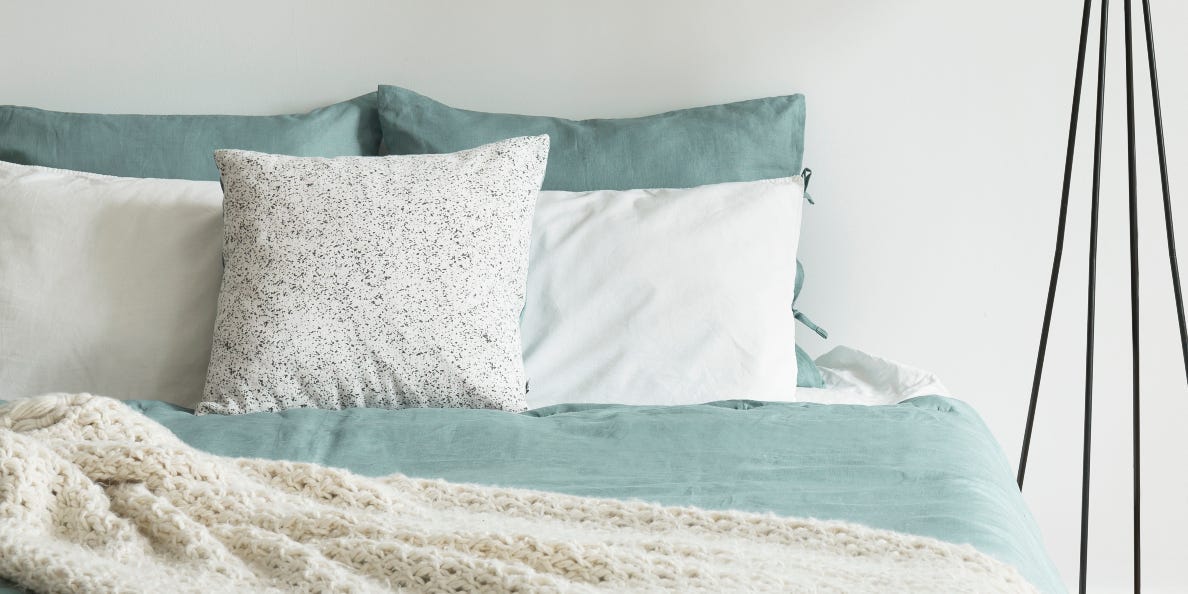
KatarzynaBialasiewicz/Getty Images
- While most pillows can be cleaned in a washing machine, buckwheat and memory foam must be spot-treated or hand-washed.
- Bed pillows should be cleaned once a season, while throw pillows can be done annually depending on use.
- Plan to change out bed pillows every two years — or when they no longer fluff up and provide support, even after cleaning.
- Visit Insider’s homepage for more stories.
As you’re putting together your cleaning checklist, don’t forget to add “wash the pillows” to your to-do’s. Even if you make it a point to launder your bedding regularly, chances are your actual pillows aren’t getting the TLC they deserve.
Because the germs, bacteria, and fungi that build up over time in unwashed bedding also apply to the fillings inside your pillows. Cleaning your pillows a few times a year will not only make them soft, fluffy, and clean all over again, but it’ll also make them last longer. If you’re ready to take the next step, we spoke to Patric Richardson, also known as the Laundry Evangelist, for tips on cleaning and caring for your pillows.
Care instructions for different fill types
With the exception of memory foam, buckwheat, or pillows marked “dry clean only,” most pillows can be cleaned in the washing machine on the gentle cycle. The stuffing inside the pillow determines how it should be laundered, but take time to read the cleaning instructions on the label before throwing it in the wash.
| Filling type | Washing | Drying |
| Down or feather | Machine-washable on the delicate cycle | Tumble-dry on delicate or low heat setting |
| Polyester or synthetic down | Machine-washable on the delicate cycle | Tumble-dry on delicate or low heat setting |
| Memory foam and latex | Spot-treat as necessary | Hang dry in area with plenty of air circulation |
| Buckwheat hulls | Spot-treat as necessary | Hang dry in area with plenty of air circulation |
When washing pillows, it’s ideal to use a natural laundry soap, which is easier to rinse out. Laundry detergent also works, but is more likely to leave soap residue. If laundry detergent is all you have, add it sparingly – about one tablespoon for each pillow – and set your machine for an extra rinse to ensure the soap is fully removed.
How often should you wash pillows?
How frequently you wash your pillows really depends on how often you use them. Since bed pillows are used daily, they typically need to be washed once every season (or about four times per year) at minimum, says Richardson. Throw pillows, in comparison, can be washed once a year or more often if need be, depending on how much use they get each day.
How to spot-treat pillows
Buckwheat and memory foam pillows should never cleaned in a washing machine. Instead, your best bet is to spot-treat any stains as they happen. You can use a stain remover or mild soap and water. To do so, saturate the stain and gently "feather the water ring out by using a dry towel, starting in the middle and wiping from the center out."
For other pillow types, and for stains like blood or saliva, you can pre-treat them with a stain remover before washing. For yellow sweat stains in particular, Richardson suggests treating the stain with oxygen bleach added to some warm wash water. And if you're looking to treat a sweat-stained throw pillow made of wool or silk, Richardson says to use sudsy ammonia in lieu of oxygen bleach.
Keeping pillows fresh between deep cleans
The easiest way to extend the life of your pillows is to invest in a pillow cover or protector. Not to be confused with a pillowcase, pillow covers typically have a zippered closure and are designed to be an added barrier. That way, you can simply just wash the cover or case more frequently.
Aside from washing your covers and cases regularly between deep cleans, Richardson points to a not-so-obvious, yet very clever means of freshening up your beloved headrests: essential oils - or vodka. The grain-based liquor is an effective non-toxic odor neutralizer that doesn't leave any scent of its own.
"Either spray [your pillows] with vodka or toss them into the dryer with a wool ball scented with an essential oil" to remove any built up odors.
When should you replace your pillows?
So you've washed and dried your pillows endless times over the last few months or years and now they're just not quite as snuggly as they used to be, right? Well, that's when you know it's time for a swap. "If you can't fluff them back up," Richardson says, "it is time to change them. After all, the best part of a pillow is that it is comfy!"
Insider's takeaway
Most pillows - with the exception of buckwheat and memory - are machine- and dryer-friendly. To keep pillows fresh between deep cleans, spot treat with some soap and water, or spritz with a vodka or essential oil spray to remove odors.